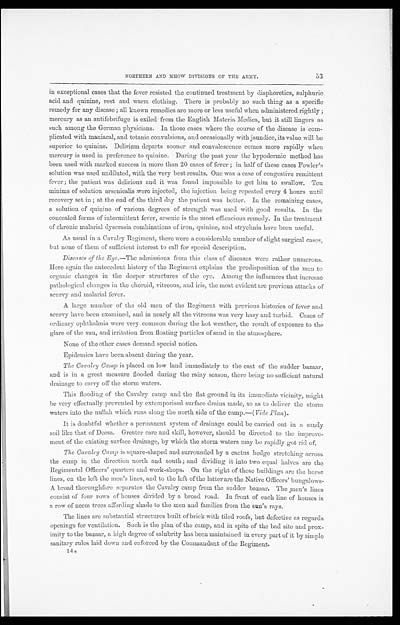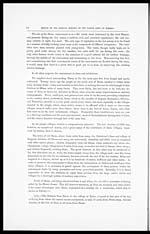Medicine - Institutions > Army health reports and medical documents > Sketch of the medical history of the native army of Bombay > Sketch of the medical history of the native army of Bombay, for the year 1870
(126) Page 53
Download files
Individual page:
Thumbnail gallery: Grid view | List view

53
NORTHERN AND MHOW DIVISIONS OF THE ARMY.
in exceptional cases that the fever resisted the continued treatment by diaphoretics, sulphuric
acid and quinine, rest and warm clothing. There is probably no such thing as a specific
remedy for any disease; all known remedies are more or less useful when administered rightly;
mercury as an antifebrifuge is exiled from the English Materia Modica, but it still lingers as
such among the German physicians. In those cases where the course of the disease is com-
plicated with maniacal, and tetanic convulsions, and occasionally with jaundice, its value will be
superior to quinine. Delirium departs sooner and convalescence comes more rapidly when
mercury is used in preference to quinine. During the past year the hypodermic method has
been used with marked success in more than 20 cases of fever; in half of these cases Fowler's
solution was used undiluted, with the very best results. One was a case of congestive remittent
fever; the patient was delirious and it was found impossible to get him to swallow. Ten
minims of solution arsenicalis were injected, the injection being repeated every 4 hours until
recovery set; at the end of the third day the patient was bettor. In the remaining cases,
a solution of quinine of various degrees of strength was used with good results. In the
concealed forms of intermittent fever, arsenic is the most efficacious remedy. In the treatment
of chronic malarial dyscrasia combinations of iron, quinine, and strychnia have been useful.
As usual in a Cavalry Regiment, there were a considerable number of slight surgical cases,
but none of them of sufficient interest to call for special description.
Diseases of the Eye .—The admissions from this class of diseases were rather numerous.
Here again the antecedent history of the Regiment explains the predisposition of the men to
organic changes in the deeper structures of the eye. Among the influences that increase
pathological changes in the choroid, vitreous, and iris, the most evident are previous attacks of
scurvy and malarial fever.
A large number of the old men of the Regiment with previous histories of fever and
scurvy have been examined, and in nearly all the vitreous was very hazy and turbid. Cases of
ordinary ophthalmia were very common during the hot weather, the result of exposure to the
glare of the sun, and irritation from floating particles of sand in the atmosphere.
None of the other cases demand special notice.
Epidemics have been absent during the year.
The Cavalry Camp is placed on low land immediately to the east of the sudder bazaar,
and is in a great measure flooded during the rainy season, there being no sufficient natural
drainage to carry off the storm waters.
This flooding of the Cavalry camp and the flat ground in its immediate vicinity, might
be very effectually prevented by extemporised surface drains made, so as to deliver the storm
waters into the nullah which runs along the north side of the camp.—(Vide Plan).
It is doubtful whether a permanent system of drainage could be carried out in a sandy
soil like that of Deesa. Greater care and skill, however, should be directed to the improve-
ment of the existing surface drainage, by which the storm waters may be rapidly got rid of.
The Cavalry Camp is square-shaped and surrounded by a cactus hedge stretching across
the camp in the direction north and south; and dividing it into two equal halves are the
Regimental Officers' quarters and work-shops. On the right of these buildings are the horse
lines, on the left the men's lines, and to the left of the latter are the Native Officers' bungalows.
A broad thoroughfare separates the Cavalry camp from the sadder bazaar. The men's lines
consist of four rows of houses divided by a broad road. In front of each line of houses is
a row of needs trees affording shade to the men and families from the sun's rays.
The lines are substantial structures built of brick with tiled roofs, but defective as regards
openings for ventilation. Such is the plan of the camp, and in spite of the bad site and prox-
imity to the bazaar, a high degree of salubrity has been maintained in every part of it by simple
sanitary rules laid down and enforced by the Commandant of the Regiment.
14 s
Set display mode to: Large image | Zoom image | Transcription
Images and transcriptions on this page, including medium image downloads, may be used under the Creative Commons Attribution 4.0 International Licence unless otherwise stated. ![]()
| Permanent URL | https://digital.nls.uk/75007116 |
|---|




